Birding enthusiasts are often drawn to the vast and captivating world of avian species, each offering a unique glimpse into the wonders of nature.
Among these treasures lies the Blue-Faced Malkoha, a lesser-known gem within the cuckoo order of birds.
Its striking feature sets this species apart: a vivid blue face, serving both practical and aesthetic purposes in mate selection and territorial display.
Native to the lush landscapes of Southeast Asia, particularly Sri Lanka and India, these birds thrive in dense forests and jungles, blending seamlessly into their verdant surroundings.
Despite its relative obscurity among casual birdwatchers, the Blue-Faced Malkoha’s captivating presence warrants exploration and appreciation, shedding light on the beauty and diversity of our avian companions.
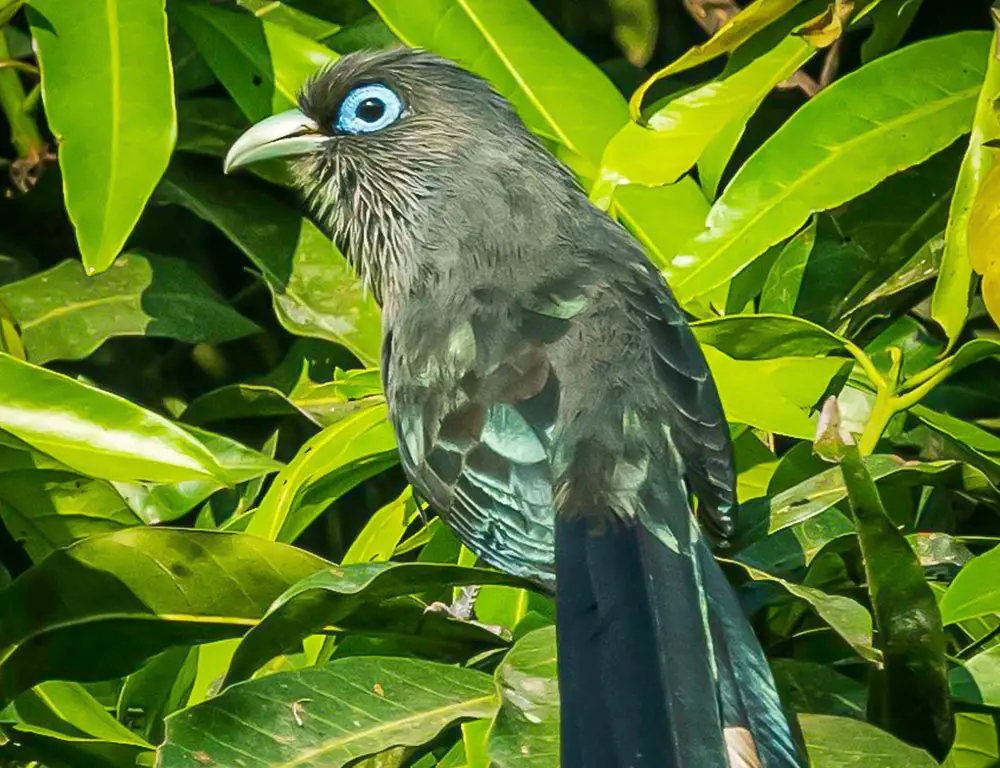
Physical Characteristics of the Blue-Faced Malkoha
The Blue-Faced Malkoha (Phaenicophaeus viridirostris) is renowned for its striking appearance and possesses several notable physical characteristics:
Blue Facial Skin
As its name suggests, one of the most distinctive features of the Blue-Faced Malkoha is its vibrant blue facial skin.
This intense coloration surrounds the eye and extends to the base of the bill, creating a stark contrast against the bird’s predominantly grey plumage.
Grey Plumage
The Blue-Faced Malkoha exhibits predominantly grey plumage, with shades ranging from pale grey to darker slate grey. This coloration provides effective camouflage within its forested habitat.
Long Tail
Another prominent feature of the Blue-Faced Malkoha is its long tail, contributing to its graceful appearance. The tail feathers are often prominently displayed during flight and play a role in balancing the bird as it moves through the dense vegetation of its habitat.
Size
The Blue-Faced Malkoha falls within the medium range of sizes among cuckoos. On average, it measures between 44-46 cm in length from tail-tip to beak-end, making it larger than some other cuckoo species.
Weight
Despite its relatively large size, the Blue-Faced Malkoha is light. On average, it weighs around 95 grams, comparable to a smartphone’s weight.
Bill
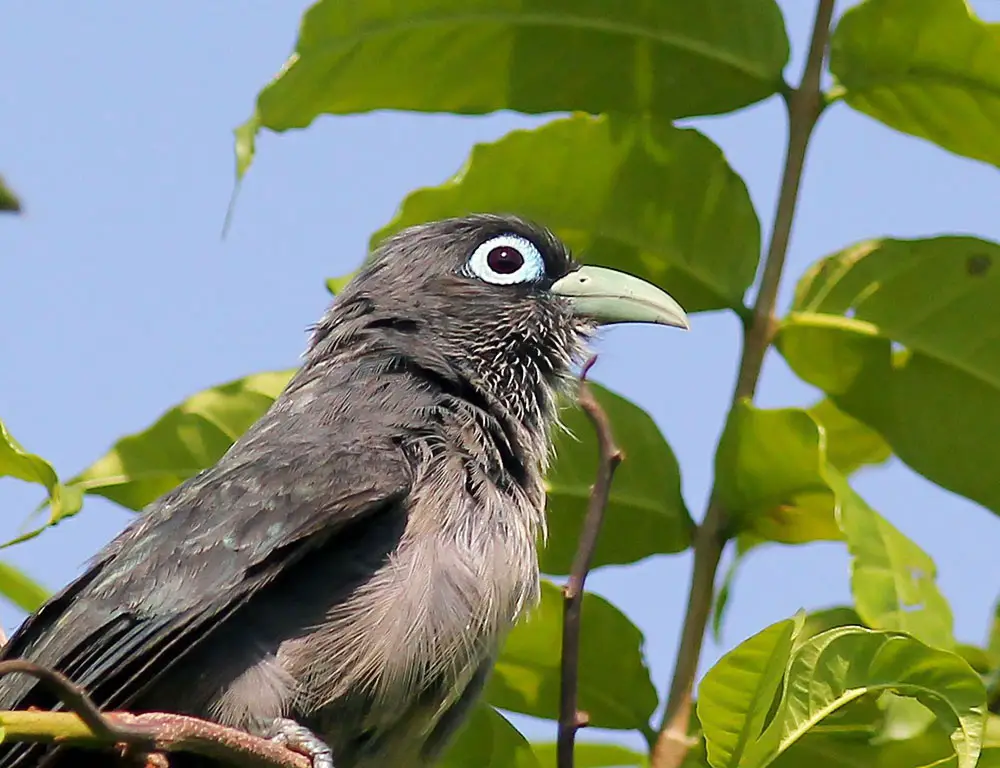
The bill of the Blue-Faced Malkoha is stout and slightly curved, adapted for capturing and consuming its primarily insectivorous diet. While the bill is not blue like the facial skin, it complements the bird’s overall appearance.
Sexual Dimorphism
Adult males and females of the Blue-Faced Malkoha generally exhibit similar coloration, making it challenging to differentiate between the sexes based on appearance alone. However, subtle differences in size or behavior may exist between males and females.
Habitat and Distribution of the Blue-Faced Malkoha
The Blue-Faced Malkoha (Phaenicophaeus viridirostris) is native to Southeast Asia’s lush forests and wooded areas, mainly found in regions such as Sri Lanka and parts of the Indian subcontinent.
Here’s a detailed look at its habitat and distribution:
Natural Habitat
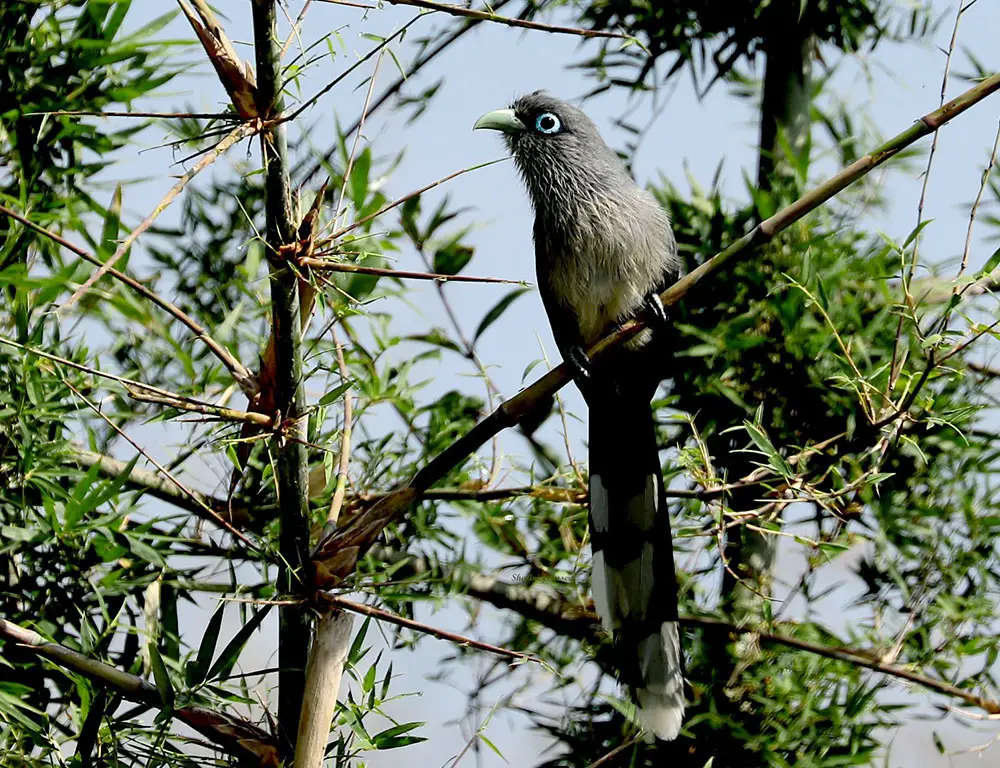
Blue-faced Malkohas are primarily found in dense tropical and subtropical forests, including rainforests, deciduous woodlands, and plantations. They prefer habitats with thick foliage and ample vegetation covering foraging, nesting, and roosting.
They are often seen skulking through the undergrowth or perching on branches within their forested habitats.
Geographic Range
The Blue-Faced Malkoha distribution extends across several Southeast Asian countries. Key regions where they are commonly found include:
- Sri Lanka: Blue-faced Malkohas are prevalent throughout Sri Lanka, inhabiting various forested areas across the island nation.
- India: They are also found in parts of India, particularly in regions with suitable forest habitats. This includes the Western Ghats, Eastern Ghats, and other forested areas of southern and central India.
- Other Southeast Asian Countries: While less common compared to Sri Lanka and India, Blue-Faced Malkohas can also be found in neighboring countries such as Nepal, Myanmar, Thailand, Cambodia, Malaysia, and Indonesia. Their presence in these countries is often associated with suitable forested habitats.
Preferred Elevations
Blue-faced Malkohas are typically found at lower elevations within their range. While they may occur in various elevations, they are generally not observed at altitudes above 1000 meters.
They prefer lowland forest habitats, where conditions are conducive to their foraging and nesting behaviors.
Behavior and Diet of the Blue-Faced Malkoha
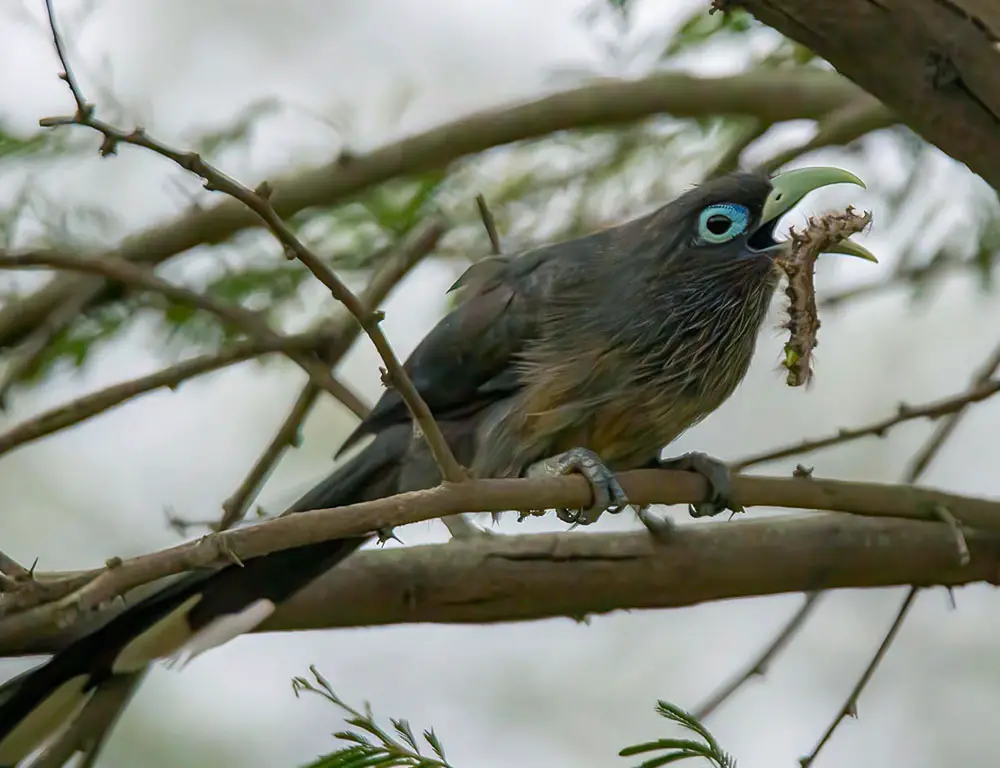
The behavior and diet of the Blue-Faced Malkoha are fascinating aspects of its ecology, showcasing its unique adaptations and lifestyle:
Feeding Habits
Blue-faced Malkohas primarily rely on insects as their primary source of sustenance. Their diet includes a variety of insects, such as beetles, caterpillars, grasshoppers, and crickets.
However, they are not strictly insectivorous and may consume small vertebrates like lizards, amphibians such as frogs, and occasionally seeds when insect prey is scarce.
Their hunting technique involves foraging in dense foliage, where they deftly move through the vegetation in search of prey. The long tail of the Blue-Faced Malkoha aids in balancing as they navigate through branches and foliage.
Foraging Behavior
Blue-faced Malkohas are predominantly arboreal birds, often foraging in the forests’ lower and middle canopy layers. They move swiftly through the foliage, using their sharp bills to capture prey items.
While they may forage alone or in pairs, they are also known to forage in small groups, particularly during breeding. Group foraging allows them to cover more ground and increases their chances of locating prey.
Breeding and Nesting
Blue-faced Malkohas are monogamous breeders, forming pairs during the breeding season, typically between March and July.
Nest-building is a cooperative effort between the male and female birds, who construct their nests high in trees using twigs, leaves, and other plant materials.
The female lays a clutch of eggs, which both parents then incubate. After hatching, both parents share the responsibility of caring for the chicks until they are ready to fledge, typically around three weeks after hatching.
Social Behavior
While Blue-Faced Malkohas are often observed foraging alone or in pairs, they may also interact with conspecifics, particularly during the breeding season. These interactions may include vocalizations, displays, and territorial behaviors.
Conservation Status of the Blue-Faced Malkoha
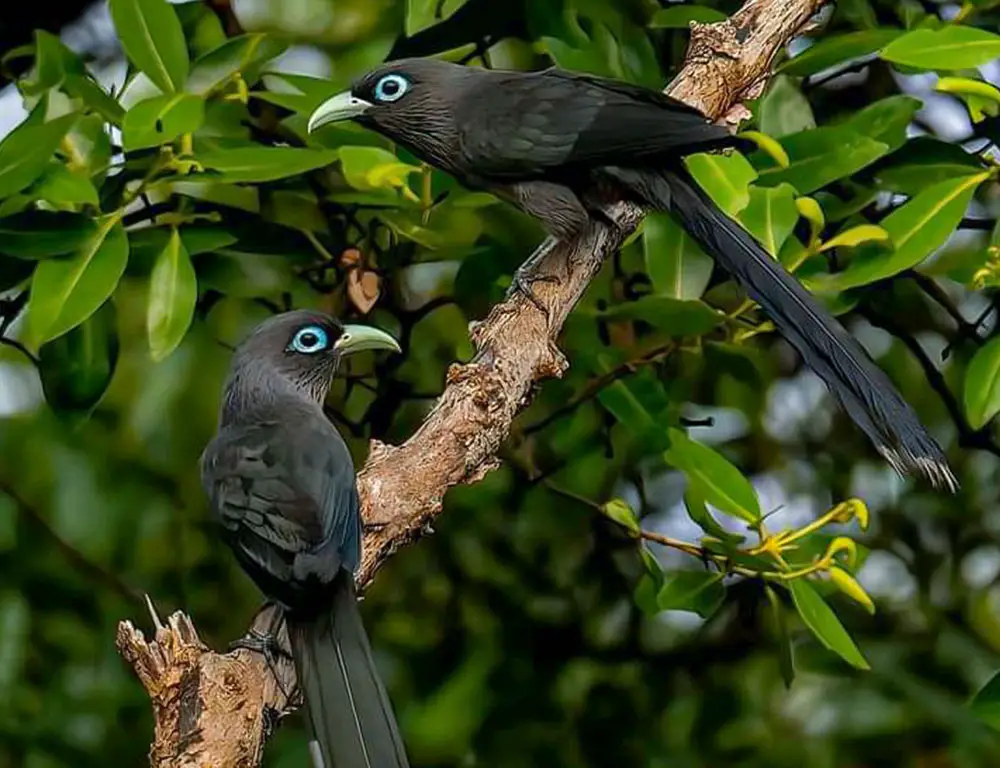
The conservation status of the Blue-Faced Malkoha is concerning, with the species classified as “Near Threatened” by the International Union for Conservation of Nature (IUCN).
This designation indicates that the species faces a high risk of extinction in the wild if current threats continue unabated.
Several factors contribute to the conservation challenges facing the Blue-Faced Malkoha:
Habitat Loss and Degradation
The primary threat to the Blue-Faced Malkoha is habitat loss and degradation due to rapid urbanization, agricultural expansion, and deforestation.
The conversion of forests into agricultural land, plantations, and human settlements results in the loss of suitable bird habitats, reducing their available nesting sites and food resources.
Population Decline
Population surveys indicate a decline in Blue-Faced Malkoha numbers over the years, with estimates suggesting a decrease from 10,000-20,000 individuals in 2000 to 7,000-14,000 individuals in 2020.
This decline underscores the urgency of conservation action to mitigate further population loss and prevent the species from reaching critically endangered status.
Conservation Efforts
Despite the challenges, efforts are underway to protect the Blue-Faced Malkoha and its habitat. Organizations such as BirdLife International monitor population trends and advocate for conservation measures.
Local communities are encouraged to participate in conservation efforts, and protected areas have been established within the bird’s range to safeguard critical habitat.
Further Action Needed
While conservation efforts are underway, more must be done to address the threats facing the Blue-Faced Malkoha. Stricter laws on deforestation and sustainable land use practices are essential to preserve its habitat.
Additionally, continued monitoring and research are needed to understand the species’ ecology better and inform targeted conservation actions.
Conclusion
The Blue-Faced Malkoha is a captivating symbol of nature’s ingenuity and beauty. Its vivid blue face, unique call, intricate breeding habits, and adaptable feeding patterns make it a marvel in ornithology.
This bird’s allure extends beyond professional circles, captivating casual birdwatchers with its stunning appearance and fascinating behaviors.
As a nature enthusiast, delving into the world of the Blue-Faced Malkoha has been immensely rewarding, offering insights into the diversity of our planet’s wildlife.
It underscores the importance of respecting and conserving natural habitats to safeguard species like the Blue-Faced Malkoha.
Let us continue to appreciate and protect these magnificent birds, recognizing their vital role in maintaining the delicate balance of our ecosystem.